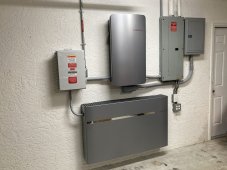Excruciatingly long thread. Can you give guidanice on your system setup?…a one-line diagram of your system? Or simple description?
ok, I’ll start looking through the thread again…seems like you’ve made a few changes over time.
Here is the "simple" description.
Main panel has 20 amp back feed breaker feeding the AC "grid" input of the Schneider XW-Pro inverter.
Output of XW-Pro inverter feeds 30 amp "main" breaker in a backup loads sub panel.
Enphase Combiner3 and the 16 iQ7 inverters with 300 watt panels feed into a 20 amp breaker in the backup loads panel.
I currently have 4 20 amp circuits from the backup panel feeding the house. the "essentials" Refrigerator, Furnace, lighting, PC, etc.
XW-Pro is connected to a 720 amp hour 14S Li NMC battery bank, Fused Class T at 250 amps.
New DC panels, total 1,000 watts is using a DC charge controller straight to the battery bank, fused at 30 amps.
System control is being done with a Triangle Research Nano-10 PLC. The PLC reads the power (watts) on the Grid, Output, and Battery connections of the XW-Pro inverter and also reads a pair of power meters measuring the consumption from the main panel. The PLC then decides when to activate charging in the XW-Pro to only use excess PV Solar production from the Enphase inverters. Charge current is adjusted every 5 seconds to maintain near zero export, and no consumption. I have it set to allow a little power export, so I know the battery is only being charged by solar, never from grid power.
The XW-Pro is programmed to block charging at 4 pm to 10 pm to make sure I am not taking any power when the grid is on the higher time of use rate. Once the battery is charged to full (or after 4 pm) the PLC will then command the "Sell to Grid" current in the XW-Pro inverter to cover the loads that are back in the main panel still. It uses the same 5 second update loop. It is capped to 16 amps back to the main panel, due to the 20 amp breaker. That is all I can use for back feed for now as it is a 100 amp panel with a 100 amp main. 20 amps puts me at the "120% rule" limit. Most of my constant loads are in the backup panel, so that power can be on top of the power going to the main panel. I have pushed it to over 5,000 watts with loads in the main panel as well as the backup panel, and the battery bank is still just coasting along.
Currently the PLC, the XW-Pro inverter, and the Enphase system are not aware of the new DC panels in any way. That system just pushes it's power directly into the battery bank. The XW-Pro stops charging at 57 volts, which is about 90% charged. The BougeRV DC charge controller can charge up to 57.6 volts or about 93% charged. It has not been able to hit that yet with just 1,000 watts of panels. It only reaches about 12 amps of charge current into my 720 amp hour battery bank. Full 100% charge would be 58.8 volts, so I am still well short of that. On a few very sunny days, I did see the battery voltage rise to 57.2 volts from the DC charging after the XW-Pro stopped charging at 57 volts.
I don't have a decent current line drawing of the system, but I will try and put one together in a few days. The power connections are fairly straight forward. It really the PLC software that makes it work. Feel free to ask any questions. I know the thread has gotten crazy long, so it can be hard to follow it all.




